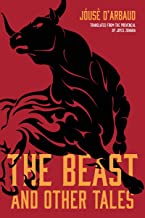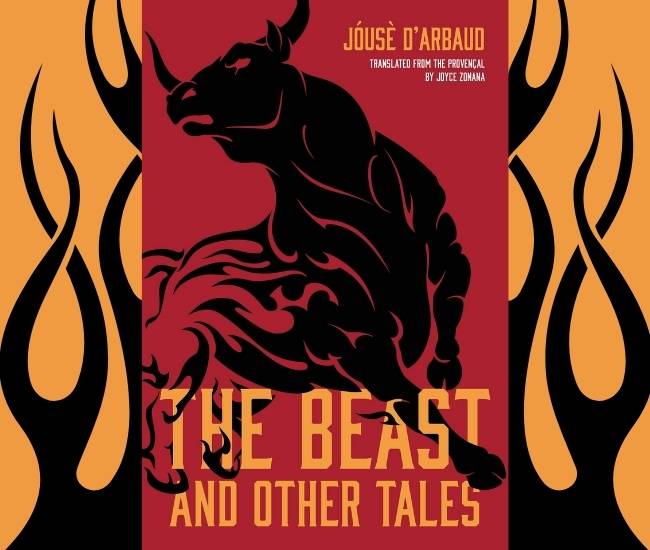The Beast And Other Tales by Jouse (Joseph) d'Arbaud
The Beast, and Other Tales (Northwestern University Press) is a skillful English-language rendering of four stories by the Provençal author Jóusè (Joseph) d’Arbaud including, most notably, his 1926 classic, “La Bête du Vacarès” (“The Beast of Vacarés”) — a haunting fantasy tale that takes place in a desolate landscape of southern France in the 15th century. Translated by Joyce Zonana, it is a beautiful and important work of literature that continues to resonate with the condition of humanity in today’s world.
In “The Beast,” a manuscript from the 15th century is found in which a lone bull herdsman (or gardian) relates the strange story of his encounter with a demigod amid the wild wetland expanses of the Carmague (the Rhone delta region). This pre-modern herdsman tells how, one day, while out on horseback, after following hoof tracks to a patch of reeds, he spots the legs of a goat, but then is horrified to realize that “… the head turning toward me had a human face.” The herdsman, terrified, makes the sign of the cross and frantically recites words of the Catholic exorcism.
Then the creature speaks: “Human, do not be alarmed. I am not the devil you dread. You are Christian, I can see that. You are Christian. But I am not a devil …”
The “beast” is pitiably scrawny and aged, but relates that before the Christian age he and his kind had lived a wondrous, rich, poetic existence: “how many suns upon suns have passed since I have seen young demigods leap in summer streams lighter than young goats?” The herdsman, despite his Christian upbringing, takes pity on the frail exile from another epoch, and he attempts to care for the creature.
THE LAST VESTIGES OF A LOST WORLD
“The Beast” is a haunting, resonant parable about the dysfunctional relationship that humans — specifically. Christians — have with nature, one that is compounded in this case by a deeply felt regionalism — one that derives identity from locality — an indigenous, and an originally pagan, regional identity. It is an identity formed through connection with nature that we are only recently learning, via ecopsychology, to fully comprehend.
The narrator is horrified by what his Christian worldview leads him to see as a demon or monster. However, he can’t deny the deep sensitivity in the eyes of the creature. He looks again for the beast in the vast marshland grazing area that he patrols. He has met the face of a receding pagan world in exile.
The creature nourishes himself on a poetic life force that he commands and glorifies. The frail demigod is reminiscent of Heinrich Heine’s Gods in Exile (1854), which tells of “that metamorphosis into demons which the Greek and Roman gods underwent when Christianity achieved supreme control of the world” when “decay is secretly undermining all that is great in the universe, and the gods themselves must finally succumb to the same miserable destiny.”
The keen insight this herdsman brings to his work and his deep knowledge of the natural world are exemplified in a passage about the taming of a wild colt. He relates that he is eager to tame the colt while on his own, seemingly in order to maximize the gentleness of the horse’s transition, emphasizing the seduction-like aspects of the process, as if striving to allow the animal the dignity it deserves. His work as a gardian requires a sensitivity to the other animals in his care — as well as to the surrounding environment — that engages his entire humanity. How do we compare the soulful, empathic handling of the colt with the herdsman’s failed stewardship in the care of the horned demigod?
Our 15th-century narrator is filled with fear and dread about his encounters with what his religion would label a demon. He is compelled to confess in church about it, yet there is also a real sense that his neglect of “the beast” may also imperil his soul.
AN ELEGIAC VISION QUEST
The tale is rich with regional detail and evocations of natural beauty. It seems to fit well in the indigenous category of vision quest, in that the individual is isolated in nature and encounters spirit guides or ancient sources of wisdom. But the message from this ancient source is forlorn and elegiac. It evokes an enchanted world forsaken alongside its banished denizens, and brings to sharp relief the spiritual toll of the Abrahamic occupation of Europe.
The cultural role of the gardian links together “The Beast” with the three other stories of this slim volume — “The Caraco,” “Pèire Guilhem’s Remorse” and “The Longline” — though these are set in the 20th century. Given that d’Arbaud worked for some time in this profession, it appears to be a rich vein to mine for insight and inspiration. Taken as a whole, The Beast, And Other Tales is a stunning literary rediscovery.





